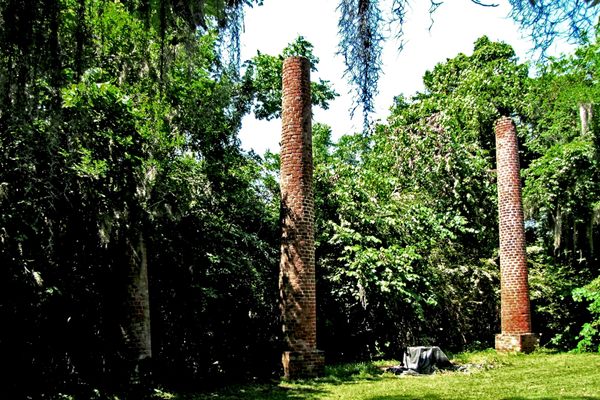Overlook Mountain House: The Skeletal Remains of a Catskills Hotel That Still Welcomes Visitors
Overlook Mountain House (all photographs by the author)
As with any hotel, visitors to Overlook Mountain House’s ruins are just passing through. The former hotel’s remains are near the summit of Overlook Mountain, which rises 3,140 feet over Woodstock, New York; hikers often use its steps for a rest before their final push to the top. But the ruins tempt many to explore further — strolling through the main hall, peering into side rooms, or posing for photos on a staircase-to-nowhere straight out of Hogwarts. Chances are it’s seeing more guests now than it did in its former life as a luxury hotel.
The ruins are what’s left of the third building on the site. The first was built in the early 1800s, when New York’s Hudson River Valley was the fashionable vacation spot for New York’s elite. Writers like Washington Irving and James Fenimore Cooper lured travelers north with accounts of the region’s unspoiled wilderness, and artist Thomas Cole’s stunning Catskill landscape paintings also sparked their interest. In 1824, developers seeking to capitalize on the travel craze built a luxury hotel, the Catskill Mountain House, in nearby Palenville; its brisk business led other Hudson Valley developers to start their own hotels.
However, the Overlook Hotel suffered some disadvantages which made for slow business. Train service to Woodstock was poor, and most travelers preferred more easily-accessible hotels. Reports of rattlesnakes in the surrounding woods also may have scared others away. The very first Overlook was a small lodge built in 1833 by a developer who planned to expand it if business took off- but it never did, and he closed after a few years. A new developer, Lewis Wagonen, tried again in 1871, erecting a 300-room hotel on the site; but business still lagged, and the hotel burned down in 1875. Two brothers from nearby Kingston rebuilt in 1878, then sold to hotelier Morris Newgold in 1917. Then the Overlook burned down again in 1921.
After two fires, Newgold figured that for the hotel’s third rebuild, he should use something less flammable. He used concrete to rebuild the hotel itself, and broke ground to add a chapel, stables, and a standalone lodge for private housing for his family. However, Newgold’s shaky finances made for slow progress, and portions of the resort were still “under construction” as late as 1939. Newgold finally gave up in 1940, selling the property to New York State.
But Newgold’s use of concrete has given the Overlook an afterlife. The Catskills’ luxury heyday ended in the early 1900s, as their clientele moved onto trendier playgrounds, with resorts closing in the 1930s and 40s. However, most of these historic resorts were demolished shortly after their closing; even the Catskill Mountain House, the most famous, was torn down and salvaged for scrap. The Overlook’s ruins are thus one of the only example of these historic Catskills resorts left standing. The ruins even suffered yet another fire in 1970, but the concrete withstood the blaze.
Hikers come to the hotel first; the trail to mountain’s summit runs straight up to the long-dry fountain and front steps. Trees grow up from the floors and in and out the windows, but there’s still a lot of room to stroll in the main hall. The lodge is also still standing, just behind the hotel, but is best viewed from outside — the floors are long gone, and it’s a ten-foot drop through the doorway down to the basement. But the metal window frames are still all in place, some still propped open as if to catch a stray mountain breeze.
You can also see the date “1928” carved into its façade, marking the date it was almost finished. Foundations for two more buildings lie in the woods off the trail, but rattlesnakes nest inside them, so it’s best to stay clear.
Back inside the main building, there’s another treat for the sharp-eyed. In 1995, artist Sarah Greer Mecklem installed a series of images inside the ruins — copies of old Overlook brochures, photos from its heyday, and articles discussing its recent decay. The installation once filled the ruins, but only a few traces remain today — just beside one window is a picture of long-gone guests peering out the same window, while in a side room the remains of a brochure urge you to “Vacation In The Catskill Mountains.”
“The intent was for these images to degrade over time,” Mecklem told Atlas Obscura, “just as the building itself has degraded through human use/abuse and exposure to weather. I actually added fertilizer to the adhesive so that when the paper peeled off the wall and landed on the ground it would add nutrients to the soil.”
Mecklem’s family lived in Woodstock when she was young, and she remembers family hikes on the mountain, riding on her parents’ shoulders as they passed the recently-closed hotel. The family moved to New York City in 1956, but Mecklem missed the Hudson Valley and returned in the 1980s. The Overlook soon caught her eye again: “I was hiking up a lot and it was the continuous flow of hikers through the ruins that inspired me to make an installation about the history of the structures. Most people had very incorrect information about the place.”
Mecklem is considering a new installation inside the ruins — possibly about those rattlesnakes, she said. But for now, you can still see some of first installation, despite 20 years of wind, rain, and graffiti — stubbornly staying put, like the Overlook itself.
OVERLOOK MOUNTAIN HOUSE RUINS, Woodstock, New York































Follow us on Twitter to get the latest on the world's hidden wonders.
Like us on Facebook to get the latest on the world's hidden wonders.
Follow us on Twitter Like us on Facebook